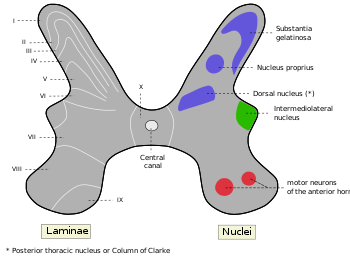Substantia gelatinosa of Rolando
The apex of the posterior grey column, one of the three grey columns of the spinal cord, is capped by a V-shaped or crescentic mass of translucent, gelatinous neuroglia, termed the substantia gelatinosa of Rolando (or SGR) (or gelatinous substance of posterior horn of spinal cord), which contains both neuroglia cells, and small nerve cells. The gelatinous appearance is due to a very low concentration of myelinated fibers. It extends the entire length of the spinal cord and into the medulla oblongata where it becomes the spinal nucleus of the trigeminal nerve.
| Substantia gelatinosa of Rolando (SGR) | |
|---|---|
 Substantia gelatinosa of Rolando is Rexed lamina II, labeled at upper left. | |
| Details | |
| Identifiers | |
| Latin | substantia gelatinosa cornu posterioris medullae spinalis |
| MeSH | D013376 |
| TA | A14.1.02.119 |
| FMA | 74019 |
| Anatomical terminology | |
It is named after Luigi Rolando.
It corresponds to Rexed lamina II.[1][2]
Function
The substantia gelatinosa is one point (the nucleus proprius being the other) where first order neurons of the spinothalamic tract synapse.
Many μ and κ-opioid receptors, presynaptic and postsynaptic, are found on these nerve cells; they can be targeted to manage pain of distal origin. For instance, neuraxial administration of opioids results in analgesia primarily by action in the dorsal horn of the spinal cord in the substantia gelatinosa where they inhibit release of excitatory neurotransmitters such as substance P and glutamate and inhibit afferent neural transmission to the brain from incoming peripheral pain neurons via hyperpolarization of postsynaptic neurons.
C fibers terminate at this layer. Thus the cell bodies located here are part of the neural pathway conveying slowly conducting, poorly localized pain sensation. However, some A delta fibers (carrying fast, localized pain sensation) also terminate in the substantia gelatinosa, mostly via axons passing through this area to the nucleus proprius. Thus, there is cross talk between the two pain pathways.
References
This article incorporates text in the public domain from page 753 of the 20th edition of Gray's Anatomy (1918)
- Baba H, Shimoji K, Yoshimura M (February 2000). "Norepinephrine facilitates inhibitory transmission in substantia gelatinosa of adult rat spinal cord (part 1): effects on axon terminals of GABAergic and glycinergic neurons". Anesthesiology. 92 (2): 473–84. doi:10.1097/00000542-200002000-00030. PMID 10691235.
- "SpringerLink - Journal Article".